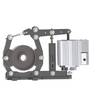ISO: Affordable & Reliable Workboat Comms
The commercial shipping world can benefit from greater range of communications and reduced satellite costs. Domestic brown water operators know all too well that’s easier said; than done. Until now.
In the fast moving world of blue water, deep draft shipping, the availability of reliable ship-to-shore communications has been a non-issue for at least two decades. More than ever, they need it. These longtime users of so-called ship management software and now, sophisticated remote monitoring systems that watch over even the most obscure minutia on board far flung 1,000 foot ocean liners, need (and get) robust and reliable communications.
On the domestic, brown water side of the equation? Not so much. The unreliability and patchwork coverage of cellular communications – both coastwise and on the inland rivers – has long bewitched brown water operators. To be fair, smaller workboats historically haven’t had the need for robust vessel-to-shore connection. But, that reality is changing.
Take the subchapter M crowd for example; with 5,000+ previously uninspected vessels now expected to stand up safety management schemes. Long the standard out at sea, in coastwise routes, these software solutions were the exception, rather than the rule. And then, there’s the evolving need for remote monitoring of equipment. Both require reliable and robust bandwidth to synchronize office and on board operational task sets.
The standard cellular connection won’t cut it any longer. At the same time, the cost of satellite connections still (arguably) remains out of reach for many operators; especially the smaller ‘mom and pop’ fleets. What’s a mother to do? One firm, long in the business of providing secure, reliable and critical connections to a raft of shoreside customers – private, NGO and government alike – says that they have the answer.
Meet Agile Marine Technologies
Agile Marine’s ruggedized, longer-range hardware and services keep business going and connected while reducing communications costs. Although new to the commercial maritime space, this is also not their first rodeo.
Sheryar Wahid, Agile’s co-founder and Chief Technical Officer told MarineNews in October, “We’ve had great success with an application Agile developed and real-world tested in Fort Lauderdale, a major city in Florida for a disaster response. First responders were able to achieve secure interoperable communications with radio, cellular and Wi-Fi. With our technology installed, their command center is able to manage the connectivity of disparate radios for communications and connectivity to LTE.”
Agile reports a wide range of users for its systems and technology. For example, Doctors Without Borders (DWB) in Africa utilizes Agile’s solution to access multiple cellular gateways to receive and make phone calls anywhere in the world. DWB staff can easily and reliably connect their laptops and communicate despite the fact that these locations are remote. Since the inception of this service, Agile has upgraded and improved the system and technology from 2G to 3G, allowing better connections and higher bandwidth.
Now looking outward from their initial customer base, Agile understands that when it comes to maritime operations, time is money and staying connected with Agile Marine Technology’s new product line can avoid or reduce satellite costs and keep a vessel or fleet in touch without a hitch.
Agile Marine touts a system that facilitates built-in GPS and seamless “smart routing” between cellular and satellite that can save up to 50% on satellite costs. That means marine customers don’t have to rely solely on satellite coverage, while enjoying seamless communications at half the cost.
The intelligent hardware, named Agile 4Marine, is constantly checking all the different possible methods of communication that are available and will also select the most cost efficient one that provides a stable connection. Agile’s routing engine checks for the existence of a connection, latency, the bandwidth of connectivity and references the lowest cost routing table, selecting the most economical and efficient connection type. Wahid adds, “If the Agile 4Marine does not find any other connection than satellite, only then will it select satellite. But, if a cellular connection is found, it will re-evaluate and switch over from satellite back to cellular.”
Initially, Agile identified the yacht space first as a natural progression of its military grade package scaled for commercial use. “When we upgraded to the latest hardware technology in the beginning of 2019, we designed it to be natively applicable to marine applications, as well as the other solutions that we provide,” said Wahid, continuing, “For this reason, we decided that it was the right time to enter the marine market and we look to satisfy both the blue water and brown/inland waterway customer.”
Nuts and Bolts
At its heart, Agile’s technology package and hardware is agnostic in that it can work with any cellular provider and/or SATCOM delivery system. Hence, existing satellite or cellular contracts probably won’t be impacted by implementing the Agile system.
Here’s how it works: Agile’s marine line of military grade, ruggedized, long-range, multi-SIM card, smart routing communications technologies make maintaining cellular and internet connections seamless. The company estimates it can save on satellite costs as much as 50%. Agile Marine products boast the ability to conveniently and automatically switch from LTE to satellite and back. It covers a range of up to 25 miles offshore before automatic “smart routing” to satellite.” For the coastwise, Jones Act trades, that adds up to real savings. For inland operators not accustomed to having 24/7/365 seamless comms, the world just got a little smaller.
Agile’s state-of-the-art solutions load myriad local SIMs on a monthly regional plan. Using local carriers provides a stronger connection, more bandwidth and more capabilities beyond the traditional method of routing and satellite allowing operators to not only separate business from crew recreational use, but also resolve issues related to congested marine WiFi, spotty cellular connections or no connections whatsoever when offshore.
In a nutshell, Agile Marine’s flagship product is an LTE communications solution for ships that reduces satellite costs and provides a more robust internet connection when near shore. Agile Marine products feature sophisticated software onboard to manage cell tower ‘hand offs’ when appropriate, maximizing signal strength while at the same time automatically searching for the best throughput connection available. The bonded LTE aggregates cellular connections to maintain session persistence even if one or more connection drops as the vessel moves through the water. This requires no action by the operator.
Agile 4Marine’s U.S.-made ruggedized hardware package is taken from a solid aluminum block, designed to maximize the surface area for superior cooling, while the interior of the case is cut to the exact shape of the boards inside so that the cellular radios and processors are directly contacting the aluminum. This maximizes heat exchange allowing operations in increased temperatures, eliminating the risk of employing a cooling fan that often fails.
That the hardware’s physical footprint measures just 6”x6”2”making it ideal for workboats – inland pushboats, for example – where space is always at a premium. Installation requires a single connection to power with a second cable connection to antennas and GPS.
Navigate your Bottom Line: Be More Agile
The savings can add up, especially for those who never before thought that they could afford technologies such as remote monitoring. Indeed, a recent study extolled the possibilities of insurance breaks (reduced premiums) for those who use remote monitoring. Wahid explains, “Every insurance company has their own criteria and credentials for what is available in terms of discounts. This will become one of the stipulations of an ongoing communications stream, from vessels to shore. One day, it will become a requirement but today, it is just provided in the form of a discount.”
The percentage of savings achieved is determined by several factors. First, this might depend on the amount of time the vessel is spending on cellular coverage in inland waterways and coastal areas, as compared to the time spent on open oceans without cellular service. A second factor involves how much a customer is currently paying for satellite service. A third factor is the amount of communications they choose to allow from ship to shore on satellite vs. when they are in coastal or inland water areas. Depending on the variables, savings can exceed 50%.
With regard to the satellite portion of the equation, Agile touts what they say is ‘a low standby charge.’ We asked what that means in real practice. He replied, “This is referring to the standby charge for the satellite portion of the service. The standby charge allows the customer to have the ability to access satellite communications when needed and limits the ongoing charge to an access fee. If there is no activity on the satellite side, there is no additional charge but, the ability and contingency of ‘sailing over’ to satellite, if nothing else is available, is there.”
Beyond this, he adds, the customer does not have to do anything with the equipment for this to occur, because it is automatic.
Agile … and Flexible
While this isn’t Agile’s first rodeo when it comes to providing critical comms, it is their first foray into the marine space. It’s also true that other service providers serve similar markets and they were here first. The ability to toggle back and forth from SATCOM to cellular, as necessary and according to what service is available where, isn’t unique to Agile. Nevertheless, says Wahid, “We are unique and we believe superior. Our software is much more comprehensive because it automatically addresses many more circumstances than the competition as it selects the best choice of low cost and stable communications.”
With Agile, customers can buy on a menu basis. For example, a user might choose to only buy the hardware that goes on the ship or they can choose to buy the hardware plus the fusion server virtual SIM service that they can locate in their own facility. That said; they can buy the hardware, pay for the monthly service for the Virtual SIM and the cellular airtime, as well.
With a nod to the typical inland pushboat operator running the length of the Mississippi River, the Agile platform was designed to transmit large volumes of data over the cellular network. The greater range of the device means that the cellular coverage area is greater, resulting in minimal need for satellite usage. The virtual SIM server automatically switches between multiple cellular carriers, eliminating roaming charges and automatically choosing the provider that will give the strongest connection to the tower.
When it comes to the domestic waterfront, advancements over time have long been measured in increased deadweight tonnage, LOA and other similar metrics. Those days are over. Technology has arrived on the docks, and it now departs regularly with the vessel when it takes ‘last line.’ The final piece of that equation, especially for the workboat sector, is the communications piece. So, what about your firm? Will your transition to the next level be Agile? If not, it may not come at all. www.aisinterop.com
This article first appeared in the November 2019 print edition of MarineNews magazine.














